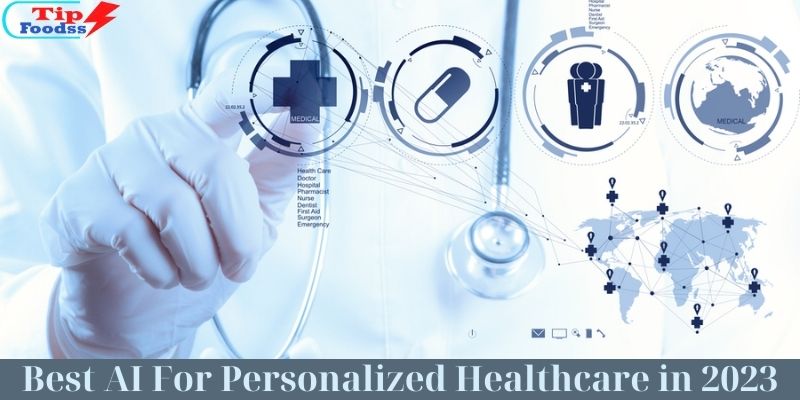Best AI For Personalized Healthcare in 2023
Generative AI, AI for personalized healthcare of artificial intelligence that can produce new material or data from pre-existing data like text, photos, audio, or video, is what will take AI conversation to the next level. Numerous uses for generative AI exist, including fostering creativity, producing lifelike simulations, enriching data sets, and upgrading data quality.
Giving each patient individualized care based on their unique requirements and preferences has been one of the major problems in healthcare. This calls for extensive data gathering and analysis from numerous sources, including patient records, lab results, imaging scans, genetic tests, wearable technology, and medical records. For the patient and the practitioner to make wise decisions, the facts must also be accurately evaluated and shared.
By using natural language processing (NLP) models to generate text or speech that can summarize medical data, explain diagnoses and treatment options, pose pertinent questions to patients or wearable technology, and offer recommendations to clinicians, generative AI can assist in overcoming these difficulties. In this article, tipfoodss.com will discuss best AI for personalized healthcare in 2023.
Contents
Collect data from patients and wearables – AI For Personalized Healthcare
Collecting pertinent data from wearables and other medical equipment as well as patients is the first step in deploying generative AI in healthcare. Wearables are gadgets that can track many aspects of health, including heart rate, blood pressure, oxygen saturation, level of exercise, and sleep quality. In addition to more conventional clinical data sources including electronic health records (EHRs), lab tests, and imaging scans, these devices can give continuous and real-time data.
However, gathering data from wearables is not without its difficulties. Not all patients have access to or want to use wearable technology. Additionally, the standards of accuracy and dependability for various wearables may vary. Additionally, wearable technology may provide a significant volume of noisy or duplicated data that needs to be filtered and processed.

By creating augmented or synthetic data that can fill in the blanks or improve the existing data, AI can aid in overcoming these difficulties. For instance:
- If a patient does not have wearable technology or gives their agreement to sharing their data, it is possible to generate realistic synthetic patients with similar traits and diseases to real patients. The size and variety of the data collection for analysis may be increased as a result.
- By identifying and correcting errors or outliers using neural network models that can learn to produce realistic samples from a given distribution of data, it can enhance the quality of wearable data.
- By leveraging different neural network models that can be trained to handle spatial or temporal information from images or sequences, it can minimize the dimensionality of wearable data by extracting pertinent characteristics or patterns.
Analyze the data – AI For Personalized Healthcare
Analyzing the patient and wearable data gathered is the second phase in the use of generative AI in healthcare. This step’s objective is to pinpoint any prospective health hazards or issues that demand more attention or treatment. By creating insights or predictions based on the evaluated data, generative AI can assist in achieving this goal. For instance:
- Based on the wearable data, it can provide written reports like summaries or visual reports with graphs.
- Using machine learning techniques, it can generate proposed diagnoses or prognoses based on wearable data to forecast future outcomes.

Query patients and wearables – AI For Personalized Healthcare
Depending on the outcomes of the analysis, the next phase in applying generative AI to healthcare is to ask patients and/or wearables. This step’s objective is to learn more about or validate existing knowledge regarding specific areas of health condition.
Based on their responses and/or wearable data, generative AI can create questions for patients. When a wearable gadget detects a low heart rate, for instance, or high blood pressure, it may ask the user how they are feeling or whether they have taken their prescription.
Address challenges – AI For Personalized Healthcare
But before generative AI in healthcare can be extensively used, there are a few issues that must be resolved, just like with any other kind of technology. A few of these are:
• Data Quality/Source: For training and testing, generative AI systems rely on vast amounts of high-quality data. However, because of human or technical mistake, medical data is frequently insufficient, inconsistent, or erroneous. The effectiveness and dependability of generative AI systems may be impacted by this.
• Data Privacy: Generative AI systems require access to private information about individuals, such as medical records or biometric information. The manner in which this data is gathered, maintained, and shared creates ethical and legal questions.
Although AI has numerous advantages, it cannot magically replace human knowledge and discretion. Here are some pointers for implementing AI in your businesses:
• Begin by formulating a clear problem statement and a specific goal.What do you hope to accomplish? How will you assess your progress?
• Evaluate the availability and quality of your data.Large amounts of trustworthy, timely, and validated data are necessary for AI to learn and function.
• Pick the appropriate degree of AI integration.Depending on the difficulty and risk of the activity, AI can support, automate, or advise human decision-making. How much supervision and involvement from people do you need?
• Include your end users and stakeholders.Workflows, roles, responsibilities, and culture are just a few of the components of your business that AI can affect.
• Assess and keep track of the effectiveness and impact of your AI.AI is a continual process of learning and development rather than a one-time undertaking.

Healthcare is a promising application for generative AI for personalized healthcare that has the potential to improve the effectiveness and quality of patient treatment. Data from patients and wearables can be collected, and analysis of the data might reveal patterns, anomalies, and trends that may point to health risks or areas for development. Nevertheless, generative AI can enhance professional decision making and give patients more control over their own health if they are aware, or perhaps even wary, of the risks.



